Why Does Jupiter Get Hit By So Many Objects In Space?
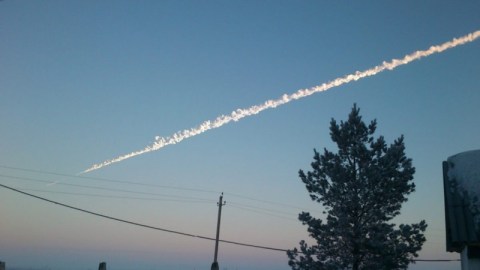
It’s the largest, most massive planet in the Solar System. But what’s the real story behind all the impacts on Jupiter?
One of the most terrifying prospects here on Earth is that of our planet being struck by a large, massive, fast-moving asteroid or comet. Even a modest fragment of such an object can strike Earth with such force that devastation will surround the impact site. If the strike deposits enough energy in the right location, like the Chelyabinsk (above) event from 2013 or the Tunguska event of 1908 could have, millions could die and many billions of dollars in property damage could occur.
The impact on Earth from even larger strikes, such as the event which created Barringer Crater or — even more catastrophically — the impactor that caused Chixulub crater some 65 million years ago, can still be measured today. Still, all the violence that Earth has experienced is nothing compared to what Jupiter, the most impacted object in the Solar System goes through.
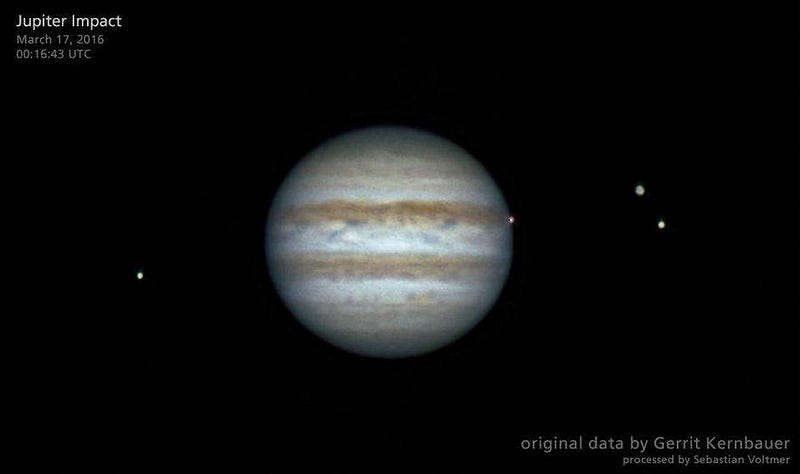
You might wonder just why this is. Is Jupiter hit the most frequently because it’s such a strong source of gravity? After all, if you exclude the Sun, Jupiter is as massive as all the remaining planets, moons, asteroids, Kuiper belt and Oort cloud objects in our Solar System combined. Or, perhaps more prosaically, is Jupiter simply struck the most frequently because it’s the largest target in the Solar System? Is it simply “too big to miss?”
A not-so-subtle reminder occurred on March 17, 2016, when two amateur astronomers — Gerrit Kernbauer (above) and John Mckeon (below) — just happened to be observing Jupiter and recording the imaging data when a surprising flash appeared at the limb of the gas giant. If you watch the video that John Mckeon uploaded to YouTube, you simply can’t miss it.
The only thing that’s known that can produce flashes like this are impact events. Although flashes get more attention than others, such as recent strikes on the Moon, Jupiter not only receives more impacts than any other world, but it receives a greater fraction of higher-energy impacts than any other known body in the Solar System. (Excluding the Sun, of course.)
In terms of flashes and strikes, we’ve observed a large number in recent years on Jupiter, thanks mostly to the efforts of amateur astronomers who enjoy gazing at it even while there are no professional telescopes watching.
Amateurs are responsible for spotting a large number of impacts over the past few years, including some of the most famous ones.

In June of 1994, comet Shoemaker-Levy 9 broke apart and collided with Jupiter, an event that had been predicted over a year in advance thanks to our understanding of gravity. The comet itself was discovered by amateur astronomers the year prior: Carolyn and Eugene Shoemaker and (independently) David Levy.
This collision led to a spectacularly successful observing campaign by professionals and amateurs alike. Although the fragments collided with Jupiter over a 6-day span, they darkened the surface of Jupiter for months. Before breaking apart into more than 20 fragments, the original comet was likely approximately 5 km in diameter: the estimated size of the impactor that wiped out the dinosaurs.
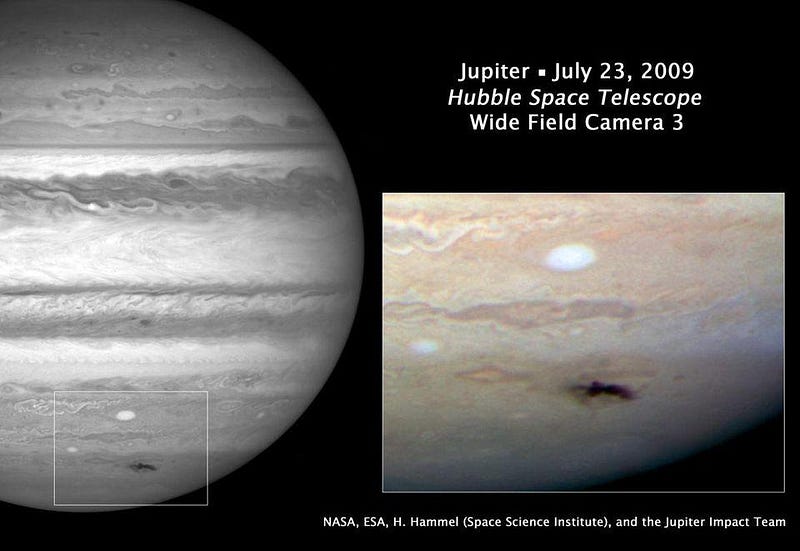
In July of 2009, a black spot the size of Earth was discovered on Jupiter by amateur astronomer Anthony Wesley. Based on what we learned from Shoemaker-Levy 9, we were able to infer the rough parameters of the body that struck it from the follow-up imaging that professionals undertook with state-of-the-art space and ground-based telescopes.
The conclusion was that this black spot likely resulted from an impact of an asteroid that was somewhere between 200 m and 500 m in size. Thousands of times the energy of the Tunguska event was released due to the impact of this object; had it struck the United States, it could have wiped out the human population of an entire Pennsylvania-sized state.
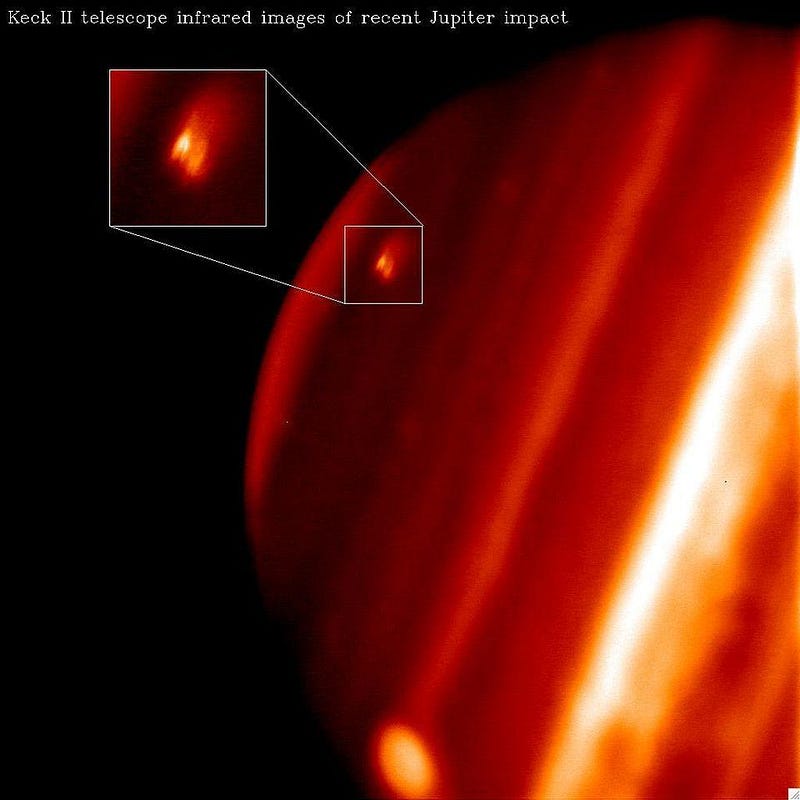
In the 2010s, though, observations of strikes on Jupiter really took off. In June of 2010, another strike was observed on Jupiter, in real-time, by Anthony Wesley (again!) and, independently, by Christopher Go. The flash lasted only two seconds, corresponding to a mass of about 500–2000 tonnes and a size of about 8–13 meters. Jupiter likely gets hit by several objects of this size every year, according to Gemini Observatory.
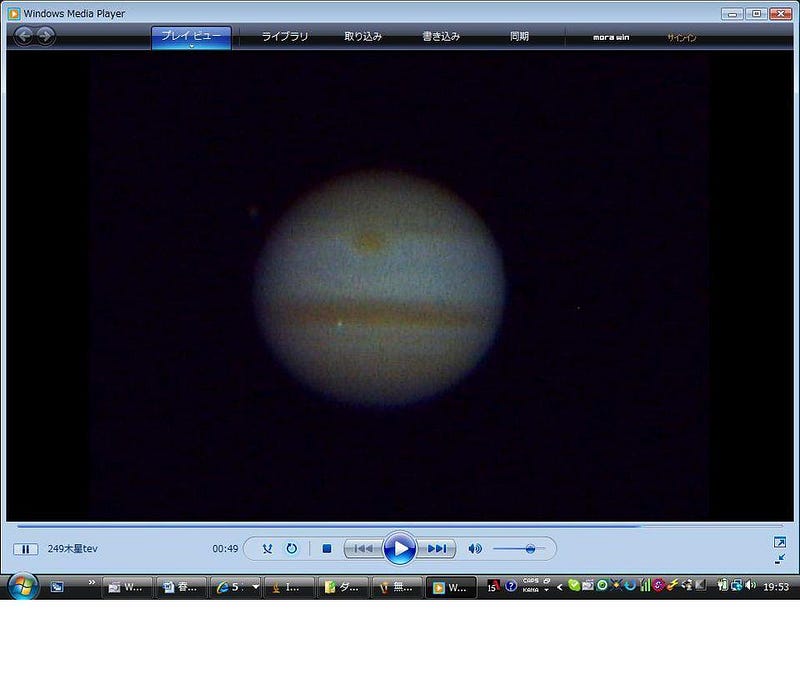
Just a few months later, in August of 2010, there was another impact on Jupiter (shown above), making a slightly smaller, lower-magnitude flash; it was likely only comparable in energy to the Chelyabinsk event. Owing to our current understanding of Jupiter, we can actually begin to classify the objects that strike it. Once again, it was discovered by another amateur: this time the honor went to Masayuki Tachikawa of Japan.
There are plenty of others, all of which have their own spectacular story. (And, sometimes, their own spectacular footage.) In September of 2012, Dan Petersen observed another “flash” on Jupiter, and this time another astronomer, George Hall, captured video of it (above). This footage enabled scientists to determine that it was approximately the same size and magnitude of the August 2010 strike: smaller than 10 meters across.
When you add in the recent March 2016 and May 2018 strikes, they were somewhere in between: smaller than the 2009 strike, but larger than the September 2012 or August 2010 strikes. Estimates put their sizes at somewhere in the range of 10-to-20 meters.
There have likely been others, and there will certainly be others to come, but all the data points to Jupiter being struck more frequently than any other world. The big question, of course, is why?
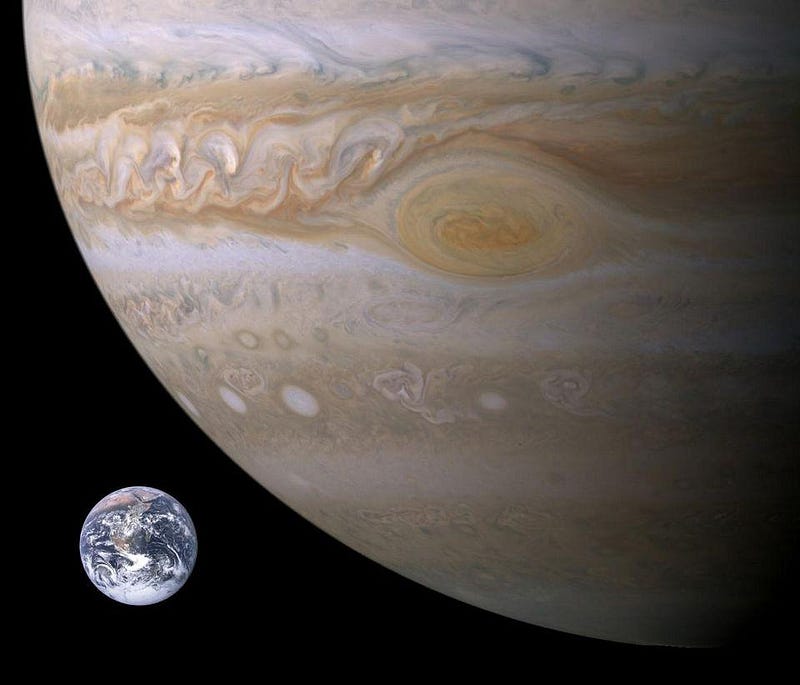
The first thing you’ll think about is size, no doubt. When we talk about the frequency of collisions in any system, the simplest estimate you can take is to multiply three things together:
- the speed of the objects (comets, asteroids, meteors, etc.) in question,
- the number density of the objects that can potentially interact,
- and the cross-section of what they might hit.
The speeds are almost exactly the same for comets and asteroids that pass by Jupiter as the ones that pass by Earth, and the number density is approximately the same too, although there’s a slight advantage to Jupiter there, due to its closer proximity to the asteroid belt. But the cross-sections are hugely different: Jupiter has approximately 11.2 times the diameter of Earth, meaning it has about 125 times the cross-section.
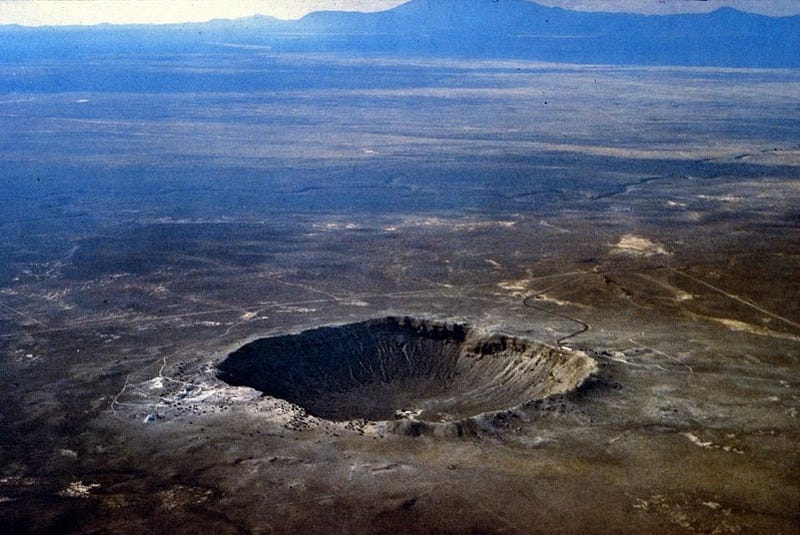
Yet the frequency of large impacts isn’t even close to being explained by size and cross-section alone. The 2009 impact on Jupiter came from an object larger than the one that made Barringer Crater (above) in Arizona, and those strikes are estimated to occur on Earth only once in the neighborhood of 10,000–100,000 years.
If it were size alone, we’d expect an impact of this magnitude no more frequently on Jupiter than once per century. Yet, we’ve seen two that were as large or larger on Jupiter in just the last 25 years! This suggests another uncomfortable fact: if Earth were hit by these large objects as frequently (for its size) as Jupiter appears to be, we’d not only see Barringer Crater-sized strikes every century or more, but we’d have extinction-level events thousands of times as often as we actually do!
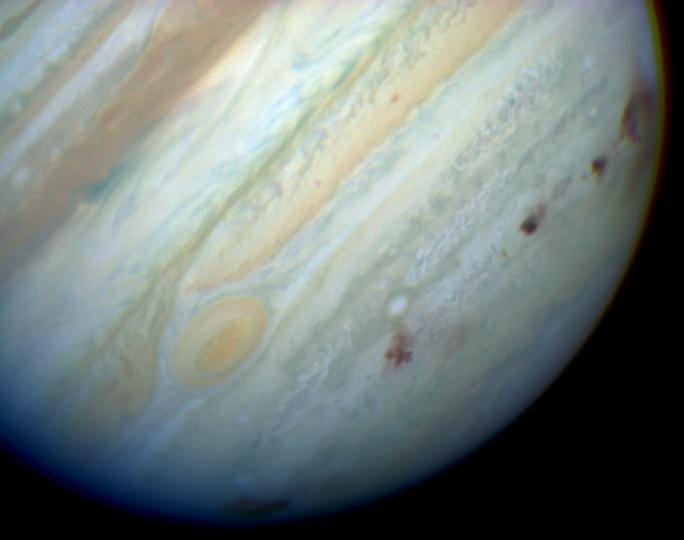
The “dinosaur-killing” asteroid was a 5–10 km-wide strike on planet Earth, occurring 65 million years ago. On the other hand, Shoemaker-Levy 9 struck Jupiter in 1994, and was that same magnitude in size and energy. Did we literally just happen to see a once-in-500,000 year event in 1994?
That’s highly unlikely. Instead, we have to consider the other main aspect in which Jupiter is different from Earth: its gravity. Planets don’t just exist in space and wait for things to run into them; they deform the fabric of spacetime itself in a fashion that’s directly proportional to their mass. The more massive a planet, the greater the gravitational attraction it exerts on all the surrounding, infalling, and nearby masses.
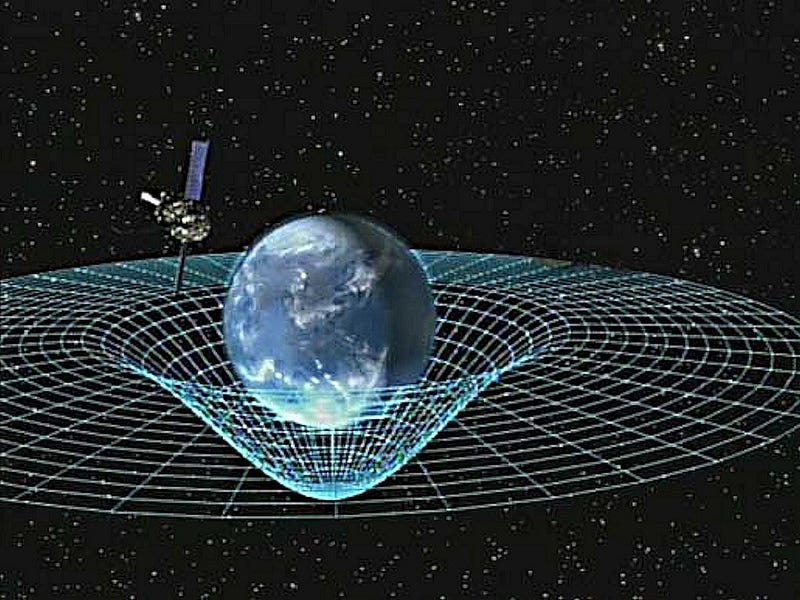
Earth’s gravitational field, by comparison, is quite the weakling when we look at it next to Jupiter. If an object passes near Earth moving slowly, at 10 km/s or less, our planet’s gravitational field will do an excellent job of attracting it towards our world. But asteroids typically move at 17 km/s or more relative to us, while comets move in excess of 50 km/s. In other words, our gravitational field doesn’t do a whole lot to help us out in the endeavor to attract objects to us gravitationally.
But Jupiter has 317 times the mass of Earth. Even with its huge radius, it does an excellent job of attracting objects to it so long as those objects move at less than 50 km/s relative to it. In other words, every asteroid and most comets that pass close to Jupiter run the risk of being pulled onto a collision course with this giant world by its gravity alone.
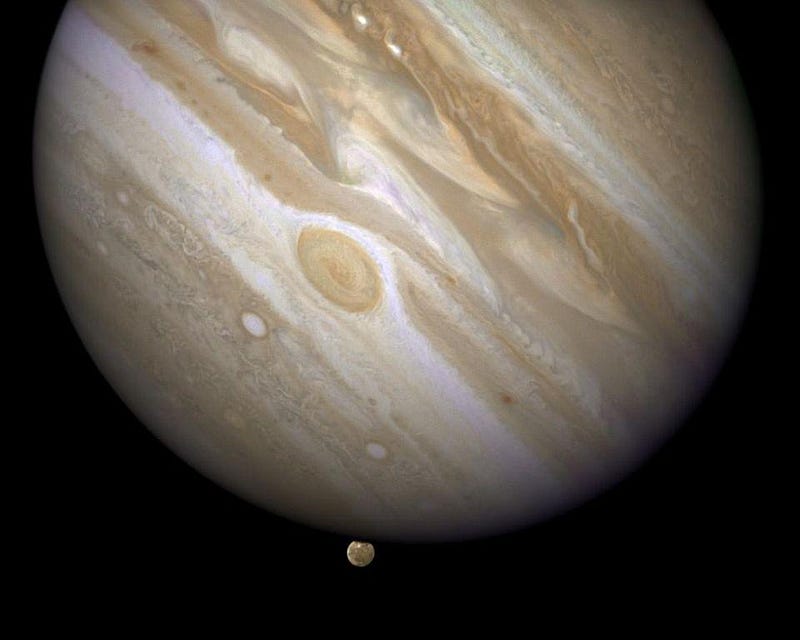
Yes, Jupiter is bigger than Earth, and that enhanced size accounts for a little over a factor of 100 in collision frequencies. But realistically, collisions on Jupiter are even hundreds of times more frequent than that. Why? Because Jupiter’s gravitational pull is sufficient to attract huge numbers of comets and asteroids that come too close to it, in a way that Earth cannot. Jupiter is struck so frequently due to a combination of gravity and the fact that objects farther from the Sun — even fast-moving comets — have slower velocities, and are therefore easier to capture.
Size does matter, but not as much as gravity does. In particular, not as much as gravity does relative to the speeds that objects near this gas giant move at. The only object in the Solar System better at capturing asteroids and comets is the Sun, but Jupiter is a very strong #2! Jupiter, contrary to popular belief, doesn’t appear to protect the inner Solar System very much at all, but rather serves as a tremendously good punching bag for objects that, otherwise, wouldn’t strike anything at all.
Ethan Siegel is the author of Beyond the Galaxy and Treknology. You can pre-order his third book, currently in development: the Encyclopaedia Cosmologica.





